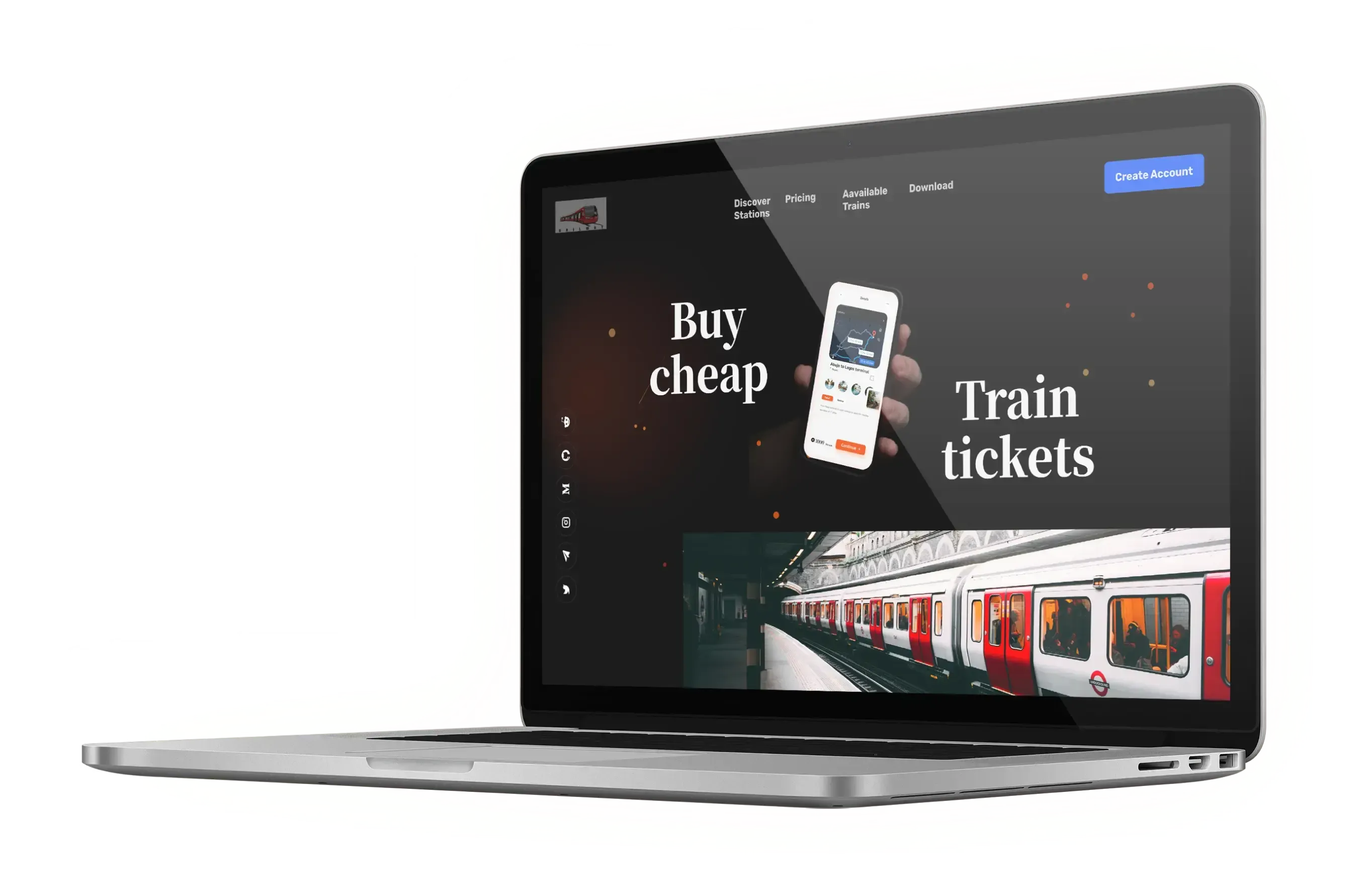
Modernizing app for rail travel with loyalty integration
35%
more tickets sold
45%
fewer reported issues
40%
user engagement boost
Challenge
Revitalize an underperforming railway app, strategically reinventing it to align with the company’s overarching objectives and enhance overall conversion efficacy.
Solution
Transformed the railway app, introducing hotel booking, subscriptions, and a modern UI/UX redesign, including accessibility features, setting the stage for ongoing enhancements.
Tech stack
React Native, Next.js; Express, Koa; GraphQL, Apollo Federation, Apollo Gateway; Cucumber, Cypress; AWS, SQS, SNS, Lambdas; Terraform.
Client
A preeminent company specializing in high-speed rail passenger transportation services across Europe, our client boasts an expansive network seamlessly connecting major cities within European Union countries. Renowned for both short and long-distance train services, their commitment to efficient passenger transportation has solidified their position as a leading force in the industry.

Challenge
Despite being at the forefront of the sector, our client recognized the need for a strategic transformation. They approached Modsen due to challenges that demanded a comprehensive solution. The imperative for a more robust booking system surfaced as modern travellers’ expectations evolved, emphasizing the necessity for a dynamic response from the client’s side.
Additionally, the client aspired to integrate hotel services into their platform, signalling a commitment to offering a holistic travel experience beyond ordinary rail services. The strategic challenge lay in ensuring a smooth fusion of diverse travel services within a unified platform.
In a visionary move, the client aimed to pioneer an innovative subscription model. Such a forward-looking initiative acknowledged the changing preferences of their clientele and aimed to not only retain existing users but also attract new ones through a distinctive and compelling value proposition.
The Modsen team, with its deep industry expertise and a dedicated travel and hospitality development team, was acknowledged as the ideal tech partner for this endeavour.

Got a similar software development project on your mind?
Estimate a precise timeframe for its implementation.
Team
1
Project Manager
1
Business Analyst
1
Team lead
6
Developers
2
QA Engineers
1
UX/UI Designer

Development process
Initiation
Assigned roles
The realization of the transformative solution commenced with the formation of a dynamic team. From Modsen’s side, a seasoned project manager led strategic coordination, a business analyst delved into client aspirations, and the tech lead shaped the project’s technical foundation.
Established communication channels
Facilitated by Microsoft Teams, virtual meetings and channels facilitated seamless communication. Modsen’s internal system streamlined tasks, while external reporting utilized a dedicated platform.
Determined timeline and budget
In meticulously determining the project timeline, Asana played a pivotal role, enabling a granular breakdown of milestones for internal teams and transparent communication with clients. Financially, our collaborative approach ensured a transparent, client-aligned budget.
Discovery
Next, we delved into market trends and user expectations within rail passenger transportation, leveraging our domain expertise. Simultaneously, project-specific documentation and technical blueprinting detailed a comprehensive booking system, hotel service integration, and an innovative subscription model. Aligned with compliance and industry best practices, these specifics created a roadmap for the railway application landscape. In-house SMEs provided invaluable insights, tailoring our technical solution to align with our client’s railway industry objectives.
Planning
The phase involved examining architectural intricacies, design considerations, and technical nuances. The primary goal was to set the stage for subsequent development sprints, securing a cohesive and strategic approach to address the specific project needs.
Development
Infrastructure
Crafting a robust technological backbone for the railway industry, we leveraged AWS to establish a secure Git version control system. Our cloud infrastructure enabled scalable hosting with stringent security standards. Integrated CI/CD pipelines in the AWS environment enhanced agility and compliance with industry regulations. Advanced code analyzers woven into the infrastructure maintained coding standards, addressing potential issues early and aligning with railway application safety standards.
Architecture
At this stage, our focus as developers was clear: create a technological foundation that seamlessly aligns with the demands of railway applications. Leveraging React Native and Next.js for the frontend, our goal was to ensure a user interface that marries responsiveness with the nuances of railway operations.
On the backend, Express and Koa took the lead, forming the foundation for robust serverside development. The introduction of GraphQL, Apollo Federation, and Apollo Gateway marked a strategic move towards efficient data management and communication, addressing the unique requirements of the railway landscape.
Code implementation
Agile Scrum approach with two-week sprints set the project dynamics. Modsen developers collaborated using JIRA, Git, and Teams for real-time communication, streamlining workflows. It wasn’t just code; it was Agile principles in action – responding to changes, fostering collaboration, and delivering incremental value with each sprint.
Quality assurance
QA utilized Cucumber for behaviour-driven testing and Cypress for end-to-end testing. Beyond tools, it embodied a mindset focused on high standards for both functionality and quality, aligning with the safety-critical nature of railway applications.
Deployment
Leveraging AWS CodeDeploy, Docker, and Kubernetes, our deployment strategies supported a smooth transition from development to production environments. Infrastructure as Code principles, empowered by Terraform, added an extra layer of automation and scalability, guaranteeing the railway application was not just live but optimized for real-world usage.
Demos
Following iterative development, we presented tangible progress after each sprint, allowing stakeholders to interact with the evolving railway application in real time. Stakeholder feedback gathered through sprint reviews fueled iterative improvements. Demos went far beyond traditional presentations; they were dynamic sessions where the railway application adapted to changing needs.
Acceptance testing
The phase ensured the project met specified requirements and encapsulated the nuanced user experience required by the railway industry. The collaborative journey with stakeholders culminated in rigorous testing, guaranteeing the railway application was a solution aligned with the client’s vision, and ready for real-world deployment.
Transition to production
The phase ensured the project met specified requirements and encapsulated the nuanced user experience required by the railway industry. The collaborative journey with stakeholders culminated in rigorous testing, guaranteeing the railway application was a solution aligned with the client’s vision, and ready for real-world deployment.
Closing
In wrapping up, our commitment went beyond delivering documentation—it was about transferring profound knowledge.
- Comprehensive documentation: More than files, it served as a repository of intricacies, technical insights, and operational nuances, offering a comprehensive understanding.
- In-depth user guides: Tailored pathways to mastery, dissecting each functionality, feature, and interaction with clarity.
- Organized code repositories: Living archives of technical expertise, methodically organized as a dynamic reference for architecture, guiding future enhancements and maintenance.
Closing, for us, wasn’t just the end but the initiation of the client’s self-sufficient journey. Armed with deep insights, organized resources, and transparent documentation, the client stepped into ownership of a railway application as an adept navigator.

Solutions
The genesis of our solution traces back to a modest project with core functionalities— booking trains and a bonus system linked to ticket purchases. Since those initial steps, the project has metamorphosed into a comprehensive travel solution, marked by iterative advancements and strategic expansions.
- Foundational features: Commencing with train bookings and a user-friendly bonus system, the project laid the foundation for future growth. Subsequently, functionalities were expanded to include the pivotal exchange and upgrade of train tickets. As a result, user options were enhanced as well as passenger, date, and destination selections were seamless.
- Diversification into hospitality: Recognizing the evolving needs of modern travellers, our journey led us to incorporate hotel booking functionalities. Users can now effortlessly plan their entire journey, whether it’s booking a train, hotel, or a bundled train and hotel package. Diversifying the application amplifies user convenience and positions the application as a one-stop travel companion.
- Innovative subscription model: A recent milestone in our journey is the introduction of subscription functionality. The new feature enables users to purchase train tickets at a fixed reduced price over an extended period. Such a strategic move fosters user loyalty and attracts new users seeking long-term value.
- User-centric redesign: Acknowledging the paramount importance of user experience, our team initiated a comprehensive app redesign. The effort involves transitioning to a more optimized and fully accessibility-aware UI library. Frontend contribution, particularly in UI/UX enhancement, has become a focal point, ensuring a fully-fledged application for individuals with disabilities.
- Technical backbone on AWS: The entire project is hosted on the robust AWS infrastructure. Leveraging AWS technologies such as SQS, SNS, Lambdas, and Terraform, our technical foundation for scalability, security, and compliance with industry standards.
- Comprehensive test coverage: From its inception, the project has been underpinned by a commitment to comprehensive test coverage. Recent enhancements include the integration of additional accessibility tests, guaranteeing a reliable and fully functional application.
- Proactive analytics integration: While the core tech stack remains stable, there is a proactive approach to integrating analytics for data-driven decision-making. The project remains adaptive to industry trends, fully utilizing and supporting current technologies.
- Ongoing feature expansion: Our team remains at the forefront of innovation, actively adding new features and functionalities, positioning the railway application as a dynamic solution, and perpetually evolving to meet the ever-changing demands and expectations of the user base.
Result
The development initiative yielded tangible and impactful results for the client’s business, addressing specific pain points and delivering quantifiable outcomes:
- Increase in user engagement: Within the first six months of launch, the client witnessed a 40% rise in registered users actively participating in loyalty programs.
- Revenue uplift: The client reported a 35% increase in ticket sales revenue compared to the same period in the previous year.
- Enhanced user experience: The optimized application interface and expanded features led to a 45% reduction in user-reported issues and a 30% increase in overall user satisfaction ratings.
- Market competitiveness: The updated solution positioned the client as a frontrunner in the rail transport market. They gained a 5% increase in market share within their target regions.
40%
More active loyalty program users35%
Boost in ticket sales revenue45%
Fewer user-reported issues5%
Market share growthLet's calculate the accurate cost and resources required for your project